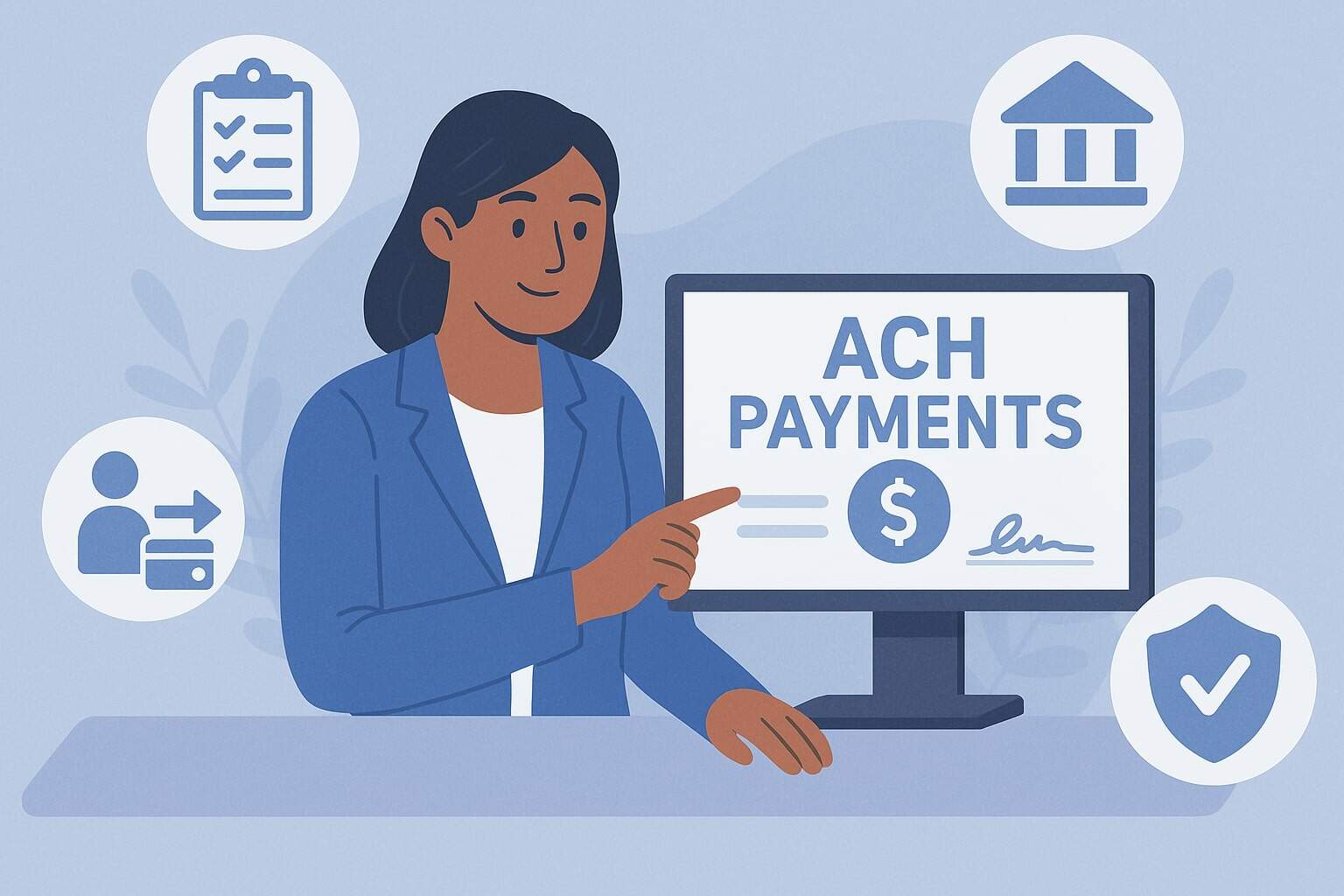
By alphacardprocess September 19, 2025
Harnessing efficient payment methods is crucial for modern businesses. Accepting Automated Clearing House (ACH) payments can open the door to new customers and streamline cash flow.
ACH payments allow secure bank-to-bank transfers that bypass paper checks and high credit-card fees, making them a cost-effective alternative for businesses.
In fact, NACHA reports that the ACH network processed 33.6 billion payments (worth $86.2 trillion) in 2024, and same-day ACH usage is surging (1.2 billion same-day payments in 2024, up 45% year-over-year).
This guide explains what ACH payments are, their benefits, how to implement them in various business models (B2B, e-commerce, service, etc.), and how ACH compares to other payment methods like credit cards and wire transfers. It also recommends specific ACH payment processors and software platforms suited to different needs.
What Are ACH Payments and How Do They Work?
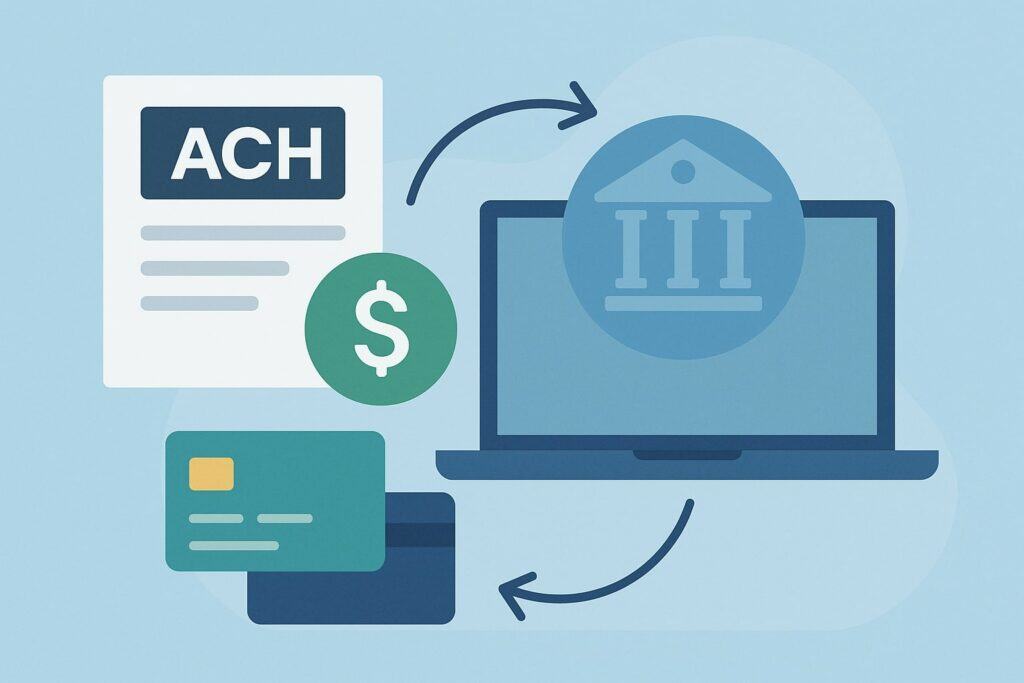
An ACH payment is an electronic funds transfer made through the Automated Clearing House network – a centralized system governed by NACHA (the National Automated Clearing House Association) that batches and routes transactions between banks.
The ACH network processes large volumes of payments efficiently. Instead of individually connecting every bank, originators (businesses or individuals) submit batches of transfers to a processing operator, which then delivers them to the recipient banks.
ACH payments are widely used in the U.S. for direct deposits (like payroll or tax refunds), automatic bill payments (utilities, loans, subscriptions), vendor invoices, and general bank-to-bank transfers.
Because ACH is a batch-based system, standard transfers typically settle in about 1–3 business days (depending on when the batch is processed). However, ACH now supports Same-Day processing for approved transactions (up to $100,000 per payment) to speed up transfers when needed.
There are two main types of ACH transactions: ACH Debits and ACH Credits. With an ACH Debit, a business (or payee) pulls funds from a customer’s bank account – for example, a utility company debiting your account for a monthly bill.
The customer must provide their bank routing and account numbers plus explicit authorization (an ACH mandate) to allow the debit. In contrast, an ACH Credit is initiated by the payer pushing funds to the business – similar to a direct deposit or payroll.
For example, a customer can pay an invoice by instructing their bank to send an ACH payment into the business’s account. Both ACH Debits and Credits travel over the same NACHA network.
Benefits of ACH Payments
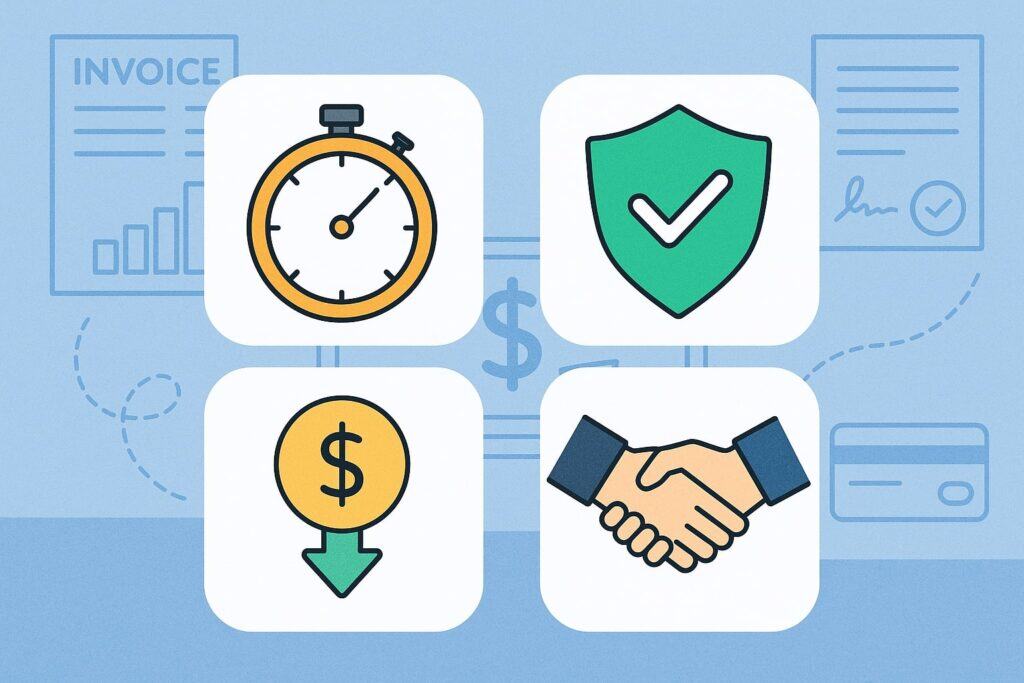
Accepting ACH payments offers many advantages for businesses:
- Lower Fees: ACH processing costs are typically a flat fee (often just a few cents or dollars) rather than a percentage. For example, many ACH providers charge roughly $0.20–$1.50 per transaction regardless of amount.
Credit card processors, by comparison, usually charge around 2–3% of the transaction (plus a fixed fee). This means on large transactions (e.g. $10,000), credit card fees could be $200–$300, whereas an ACH transfer might cost only $5–$10. Some platforms (like Nickel or Melio) even offer free ACH transfers.
In short, ACH is much cheaper, especially for high-value or recurring payments. As one payment API provider notes, “ACH transactions can cost pennies to initiate and in some cases are free”. - Predictable Recurring Billing: ACH is ideal for subscriptions or invoices. Once a customer has authorized a recurring ACH debit, businesses can automatically collect each period’s payment without needing a new credit-card authorization each time.
This reduces declines due to expired cards and ensures steady cash flow. For example, many subscription services and B2B companies rely on ACH for recurring billing because it is reliable and avoids the fee increases of card networks. - Improved Cash Flow and High Limits: Since ACH fees are low and often capped, businesses save money on processing. Clients also benefit from no-surcharge bank payments.
Offering ACH can lead savvy customers to choose it for larger invoices, freeing up capital. Additionally, the NACHA network has grown massively – in 2024 it processed more than 33.6 billion transactions – so customers increasingly expect this payment option. - Security and Trust: ACH payments are highly secure. Transfers are encrypted and subject to strict banking protocols. ACH transactions have a very low fraud rate (one Federal Reserve/Nacha study found only about $0.08 of fraud per $10,000 in ACH payments).
The ACH network is monitored by a non-profit regulator (NACHA), and processors use additional safeguards like tokenizing bank details and monitoring for suspicious activity.
Overall, bank-to-bank transfers tend to be more secure than credit-card transactions, which face higher fraud and chargeback risk. - Eliminates Checks and Manual Processes: By switching from paper checks to ACH, businesses avoid printing, mailing, and handling checks. This saves time and reduces human errors or theft risk.
As one provider notes, paper checks involve hidden costs (printing, postage, reconciliation), whereas ACH simply moves funds digitally. With ACH, even tasks like paying vendors or payroll become automated and faster, without the delay and expense of checks.
How to Accept ACH Payments
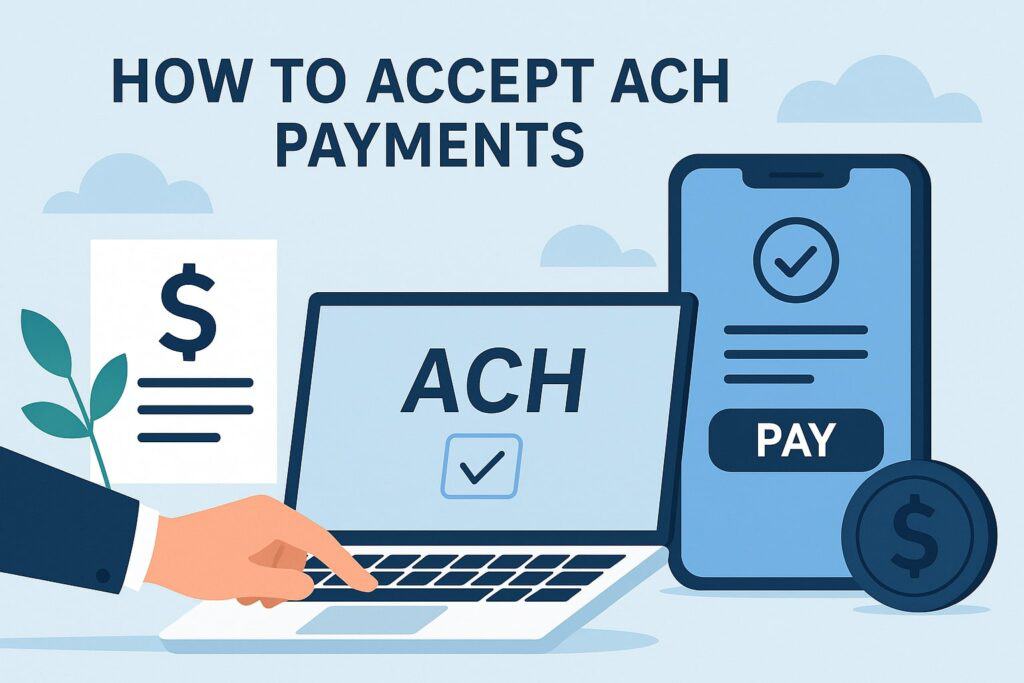
Accepting ACH payments involves a few key steps, often handled through a payment processor or your bank:
- Choose an ACH-capable provider or bank. Many banks and payment platforms support ACH. If you already have a merchant account for credit cards, ask your processor if they offer ACH or “eCheck” processing.
There are also specialized ACH providers with APIs (e.g. Dwolla, GoCardless, Stripe, Square) and accounting platforms (QuickBooks Payments, Melio, Bill.com) that include ACH. Compare pricing, features, and integration needs.
For example, Helcim offers ACH at 0.5%+25¢ (cap $6) with invoicing and virtual terminal tools, while Stripe charges 0.8% (cap $5) with powerful developer APIs. - Sign up and configure your account. Create an account with the chosen provider. You’ll need to link your business bank account (the receiving account) where funds will deposit. Some providers may set up an ACH Merchant or simply enable ACH on your existing merchant profile.
Often there are no monthly or minimum fees for ACH. Complete any required paperwork; for example, NACHA requires you to agree to follow its rules (this is typically handled by the processor). - Collect customer banking details and authorization. To debit a customer via ACH, you must have their bank’s routing number and account number, plus explicit permission (an “ACH authorization” or mandate).
This can be collected on a payment form, invoice, or signup page. Make sure to clearly inform customers how funds will be used and obtain a signed or electronic mandate.
Providers like Stripe and Square usually have built-in flows to securely capture this information during checkout. Important: Keep a copy of the authorization (digital or paper) for your records, as NACHA requires originators to have proof of consent. - Verify bank accounts (optional but recommended). Before initiating large ACH debits, verify account ownership. Many systems use micro-deposits (sending small trial amounts which the customer confirms) or instant account verification services.
For example, Stripe can send micro-deposits that customers confirm to verify their account within 1–2 days. This step helps reduce failed transactions. - Initiate ACH transfers. Once set up, create invoices or payment requests that offer an “ACH” option. Your payment processor will then submit ACH batches to the clearing house on its processing schedule.
Be aware of cutoff times for same-day ACH if you need faster settlement. Standard ACH debits typically clear within 1–3 business days, though many providers allow you to opt into same-day ACH for faster crediting (see “Same-Day ACH” below). - Reconcile and manage payments. Use your provider’s dashboard or accounting software to track incoming ACH payments. ACH transactions usually post with your bank a day after processing.
If an ACH is returned (e.g. NSF or closed account), your provider will notify you and may charge a small return fee. Handle returns promptly by contacting the customer or re-submitting if appropriate.
- Tip: To encourage ACH usage, offer customers a small discount or note that ACH has no surcharge (unlike a credit card). Many businesses label ACH as “bank transfer” or “auto-debit” in their payment options to highlight the low cost.
Comparing ACH to Other Payment Methods
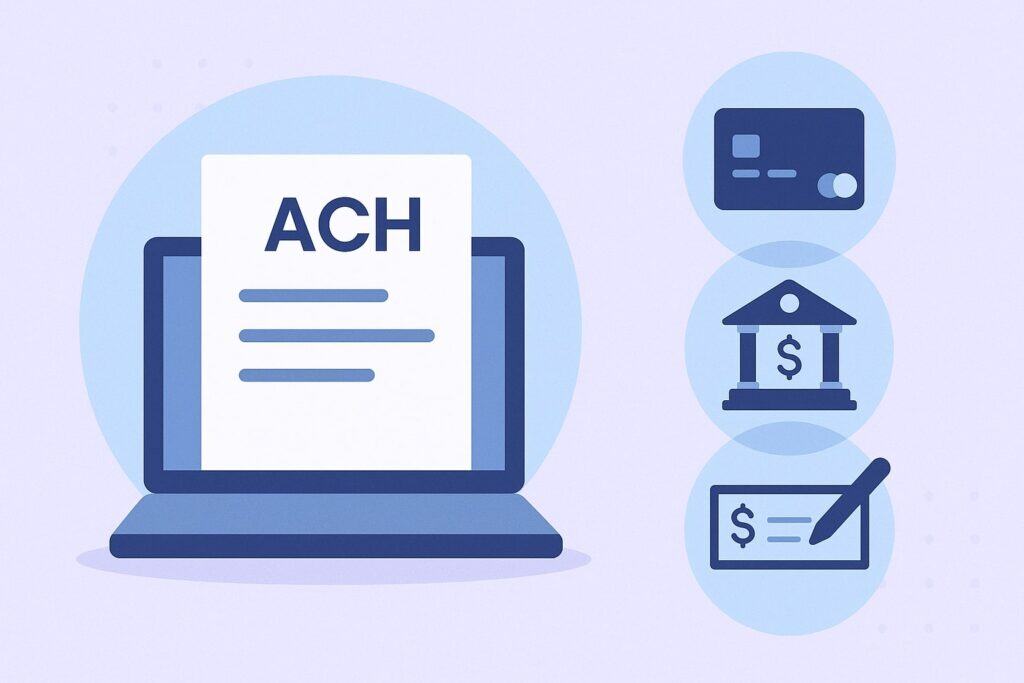
Understanding how ACH stacks up against alternative payment methods can help you choose the best mix for your business:
- ACH vs Credit Cards. Credit cards authorize immediately and funds are transferred quickly, making them ideal for point-of-sale and impulse purchases. However, cards charge higher fees (typically 2–3% of the sale plus a fixed fee).
ACH offers much lower cost (flat fees of ~$0.20–$1.50 per transaction), which greatly benefits large or recurring payments. The trade-offs are: ACH payments take longer to settle (usually 1–3 business days) and have no instant authorization guarantee.
Cards guarantee payment at the time of sale (unless a chargeback occurs), whereas ACH transfers can be returned days later (for insufficient funds, etc.).
In practice, many businesses offer both: credit cards for fast checkout and consumer convenience, and ACH for B2B/invoice payments or high-ticket transactions. As one analysis notes, “the best option is to incorporate both as payment options and let your customers decide”. - ACH vs Wire Transfers (Electronic Transfers). Wire transfers (Fedwire or SWIFT) move funds rapidly (often same-day) and are used for large domestic or international transfers. But they come at a steep cost (typically tens of dollars per transfer) and are largely irreversible.
ACH, by contrast, is a batched system through NACHA, so standard transfers take 1–3 days. ACH fees are nominal, whereas wire fees can range from $25–$50 domestically. Additionally, the ACH network is domestic only (U.S. and Puerto Rico), so for international payments you’d use wire or global networks.
In summary, use ACH for routine domestic transactions and wires only for urgent or overseas payments. The key differences (from industry sources) are that ACH is cheaper but slower, while wires are faster but costly. - ACH vs Checks. Paper checks are dying out in business. Checks can be lost, stolen, and are slow to process. They also incur printing and postage costs.
ACH eliminates these issues: payments clear electronically, usually much faster than mailing a check, and with no paper handling. Nacha notes that businesses are favoring modern ACH over checks for safety and efficiency.
In short, ACH provides the convenience of digital transfer and the security of bank verification, whereas checks carry fraud risk (stolen checks) and slower reconciliation. As one provider points out, “No more processing, mailing and tracking paper checks” means less manual work and fewer errors. - ACH vs Debit Cards. A bank debit card also pulls money from a customer’s checking account, but it routes through the card networks (Visa/Mastercard) and usually carries a merchant fee similar to a credit card (around 1–3%).
An ACH debit (using routing/account numbers) bypasses those networks. Thus, the fees are typically lower for an ACH debit than for processing a debit card via a point-of-sale system.
The downside is that a card authorizes in real-time at checkout, whereas an ACH debit still takes a day or two to settle (unless same-day ACH is used). However, for online or billed transactions, ACH is often preferred.
Choosing ACH Payment Processors and Platforms
When selecting how to accept ACH, consider the features, fees, and ease of integration:
- Stripe – A major payments platform with developer-friendly APIs. Charges 0.80% of the amount (capped at $5) per ACH direct debit.
Stripe supports both ACH Debits and Credits, provides payment links and invoicing, and offers tools like automatic reconciliation and instant account verification. Ideal for online businesses that want flexibility and integration into apps. - Square – Through Square Invoices and certain APIs, Square lets you offer ACH. Its fee is 1.0% per transaction (minimum $1).
Square’s strong suit is simplicity: it’s easy to set up if you already use Square POS or invoicing. Best for small businesses and brick-and-mortar shops that want a unified system for cards and bank transfers. - Helcim – A merchant services provider focused on transparency. Offers ACH at 0.25–0.50% + 25¢ per transaction (capped at ~$6 for high-volume transactions).
Helcim includes built-in invoicing, recurring billing, and virtual terminal features (phone/mail orders) at no extra cost. Good for SMBs wanting low fees and no monthly contracts, especially those that also want card processing bundled together. - GoCardless – Specializes in ACH/Direct Debit and recurring payments. Domestic ACH fees range roughly 0.50 – 0.75% + $0.05 (caps ~$5–$6.25 per txn); international direct debit services are higher (about 1.75 – 2% + $0.40).
It is designed for subscription and invoice billing, with automatic retry logic and embedded flows. Ideal for businesses that run memberships or global debits. - Rotessa – Focused on recurring ACH billing. Pricing starts around $17–$95 per month (depending on volume) plus a small per-transaction fee (~35¢). Suitable for businesses with steady, high-volume recurring payments (e.g. property management, professional services).
- QuickBooks Payments – If you use QuickBooks accounting, their payments add-on accepts ACH debits (via “eCheck”). The fee is 1% of each ACH payment (capped at $10). It syncs automatically with your books. Good for QuickBooks users who want seamless integration.
- Melio – A bill-pay platform popular with small businesses. Melio lets you pay suppliers by ACH for free and by credit card at 2.9%. It handles invoicing and can fund payments from your bank or card. Use Melio if you often pay vendors and want a simple interface.
- Bill.com – An accounts payable/receivable platform. ACH is usually around $0.49–$0.59 per transaction, with additional plans for various features.
Bill.com automates invoice workflows and can also accept credit cards on invoices. It suits businesses looking to automate their entire billing cycle. - PayPal / Venmo – While not ACH in name, PayPal can debit a customer’s bank account when they pay (via eCheck) with lower fees. Venmo Business allows bank payments with fees (around 1.9% + $0.10). These are convenient if many customers already use those wallets.
- Dwolla – A B2B ACH platform (API-based). Dwolla itself doesn’t list a flat rate publicly, as it partners with banks.
Many companies using Dwolla report ACH fees on par with or lower than typical rates. It is a solid choice if you need a highly customizable ACH solution (e.g. embedding ACH into your own software) and can handle some development effort.
In general, compare providers by fees, settlement times, and features (invoicing, APIs, reporting). Many platforms also include fraud detection and easy integration, so pick one that fits your technical resources and transaction volume.
Implementation Tips and Best Practices
- Streamline onboarding: Clearly explain ACH as a payment option on invoices, checkout pages, and contracts. Make the ACH authorization form easy to complete. Some businesses provide a link or QR code for customers to enter their bank details securely.
- Verify accounts when possible: Use instant verification or micro-deposits to confirm customers’ bank accounts before large transfers. This prevents failures and disputes.
- Automate reconciliation: Modern payment platforms (Stripe, Square, etc.) can automatically match incoming ACH deposits to invoices, saving manual effort. Use these tools to keep your books accurate.
- Handle returns quickly: Occasionally an ACH payment may bounce (due to insufficient funds, closed account, etc.). Stay on top of your processor’s notifications and contact the customer promptly to resolve the issue. Under NACHA rules, return reasons are limited, and funds usually return to you minus a small fee.
- Comply with NACHA rules: Maintain proper authorizations and records. If you’re a smaller business using a full-service processor, most compliance is handled for you, but you should still be familiar with basic requirements (e.g. giving customers a written receipt of authorization if requested).
- Use recurring billing features: For subscriptions or installment plans, set up recurring ACH debits in your software. This reduces manual invoicing. Many ACH processors have built-in recurring billing and retry logic for failed debits.
- Offer incentives: To encourage ACH, some businesses offer a small discount for paying via bank transfer, or simply highlight “free ACH payment” on invoices. This can nudge price-sensitive customers to choose the lower-cost option.
Security and Compliance
ACH payments are highly regulated and secure. The NACHA network has strict rules that protect both parties. Here are key points:
- Encryption and Tokenization: Modern ACH processors encrypt bank account data and often tokenize it, so sensitive account numbers aren’t stored in plain text.
- Authorization and Audit Trails: You must obtain and retain each customer’s permission before debiting their account. Processors typically log this authorization digitally. Under NACHA rules, customers can dispute unauthorized ACH debits within 60 days of notice.
- Low Fraud Risk: Because ACH payments require direct bank access and verification, fraud rates are very low. Some experts note ACH fraud is roughly 135 times lower than credit card fraud. Many providers continuously monitor transactions for anomalies.
- Industry Standards: If you handle any card data alongside ACH, you must follow PCI-DSS standards. For ACH-specific rules, adhering to NACHA operating regulations (often handled by your processor) is required.
Overall, ACH is considered a very safe payment method. As one resource notes, reputable ACH platforms “implement security measures to protect financial information” and the ACH network is centrally managed to minimize risk.
The Future of ACH and Trends
ACH payments are on the rise and continually improving:
- Same-Day ACH: Since 2021 there are three ACH processing windows per business day, allowing most transactions (up to $100,000) to clear on the same day. This has led to faster cash flow – Nacha reported 1.2 billion same-day ACH transfers in 2024.
- Growing B2B Use: Business-to-business ACH payments continue to grow. In 2024, B2B ACH volume was 7.3 billion payments (up 11.6%). This reflects companies ditching checks in favor of ACH’s safety and efficiency. For example, paying large vendor invoices or payroll via ACH is now common practice.
- Integration with Accounting/Banking Tech: ACH is getting easier to implement. Platforms like Plaid or Finicity allow one-click account linking, making ACH checkout flows smoother. Even fintech payroll or billing apps build ACH support natively, so more small businesses can adopt it.
- Competition from Faster Networks: The Federal Reserve’s new FedNow service (launched in 2023) provides instant payments 24/7, which may eventually complement ACH. However, ACH remains widely used for larger and batch transactions.
Many expect ACH and FedNow to coexist, serving different needs (ACH for batch/recurring, FedNow for instant transfers).
Businesses that embrace ACH today can save on costs and offer customers a modern, secure payment option. As digital banking grows, demand for direct bank payments continues to increase.
Frequently Asked Questions
Q: What is the difference between an ACH Debit and an ACH Credit?
A: An ACH Debit occurs when a business (the payee) pulls money from a customer’s bank account with the customer’s authorization (e.g. a recurring insurance payment).
An ACH Credit is when the payer (customer) initiates sending money to the business (e.g. paying a vendor bill). Debits are “pull” transactions by the payee; credits are “push” transactions by the payer.
Q: How long does it take for an ACH payment to arrive?
A: Standard ACH transfers usually take 1–3 business days to clear, since payments are processed in batches each night. Many processors deposit funds in 2–4 business days.
If you opt into Same-Day ACH (for transactions under $100,000), funds can arrive on the same business day. Keep cutoff times and weekends/holidays in mind, as they can delay ACH beyond the quoted times.
Q: Are ACH payments safe and secure?
A: Yes. ACH payments use encrypted bank transfers under strict NACHA rules. Customers must authorize each ACH, and the network operates securely. Industry data shows ACH fraud is very low (for example, ~$0.08 of fraud per $10,000 transacted).
Reputable payment processors also add security layers like tokenization and fraud monitoring. In practice, direct ACH transfers are considered more secure than accepting credit cards, since there is no card data exposure and strong banking controls are in place.
Q: What information do I need to accept an ACH payment?
A: You’ll need the customer’s bank routing number and account number, and permission to debit their account. Often this is collected via a secure form or payment link.
The customer signs an ACH authorization (mandate) giving you consent. You should store that authorization (digital copy or electronic record) for compliance.
Q: Is an ACH payment guaranteed like a credit-card payment?
A: No. Credit cards guarantee funds at the time of sale (assuming authorization clears). With ACH, funds actually transfer a day or two later and can sometimes be returned (for insufficient funds, a closed account, or a customer dispute).
However, returns are relatively rare. Always verify accounts and monitor batches to catch any returned ACH promptly.
Q: How much does it cost to accept ACH?
A: It varies by processor, but fees are typically a flat low charge or small percentage with a cap. For example, many providers charge around $0.25–$1.50 per ACH transaction.
Some charge a small percentage (e.g. 0.5–1%) up to a fee cap. This is generally much cheaper than credit-card fees. Always check your processor’s current rates.
Q: Can I accept ACH from international customers?
A: No. The standard ACH network is for U.S. (and Puerto Rico) accounts. Customers outside the U.S. cannot send you ACH.
For international payments, you would use global ACH schemes (like SEPA in the EU) or wire transfers/SWIFT. Some platforms let you accept foreign bank debits through separate arrangements, but that is not standard ACH.
Q: What happens if an ACH payment is returned?
A: If a transfer bounces (e.g. NSF), you’ll be notified by your processor and typically charged a small return fee. You can then contact the customer to retry or resolve the issue.
Under NACHA rules, returned transactions must be re-attempted with the same account data only once after a failed debit. After an unauthorized debit, the customer has 60 days to claim it with their bank.
Q: Do I need a special merchant account to do ACH?
A: Not usually a separate merchant account – ACH is often handled through your existing bank or payment provider. If you sign up for an ACH service (e.g. through Stripe, Square, or a bank), they effectively set up an ACH originator profile for you. No separate hardware is needed – you do it all online or through software.
Q: How do I add ACH to my online store or invoicing?
A: Many e-commerce platforms and invoicing tools have ACH options. For example, Stripe’s API supports ACH Direct Debit and you can add it to your checkout. PayPal Invoicing lets customers pay from their bank.
Accounting packages like QuickBooks and Xero have built-in ACH payment features. If your provider offers hosted payment links or virtual terminals, you can simply send an ACH payment request via email or checkout page.
Conclusion
For businesses of all types – from freelancers and online stores to B2B service providers and large enterprises – adding ACH as a payment option can be a game-changer.
ACH offers markedly lower fees than credit cards, is reliable for recurring billing, and improves cash flow by removing paper checks. The ACH network handles tens of billions of transfers each year, and Same-Day ACH is making bank transfers nearly as fast as cards.
To implement ACH, choose a capable payments provider (like Stripe, Square, Helcim, etc.), set up your account, and collect secure authorizations from customers. By integrating ACH, you make it easier for customers to pay, reduce processing costs, and future-proof your payments strategy.